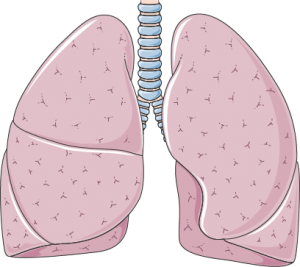Lung Neuroendocrine Tumor
Home » For Patients old » NET Tests & Treatments » NET Sites » Lung
Roughly 1 in 4 neuroendocrine tumors occurs in the lungs. A lung neuroendocrine tumor (sometimes called lung NET) may not cause symptoms in its early stages. Unrelated testing can lead to the discovery of a lung NET.7,9
Where do lung neuroendocrine tumors occur?
 Location of lung NETs: Lungs, bronchial system.
Location of lung NETs: Lungs, bronchial system.
Lung NETs may be further described based on where they occur in the lungs:
- Central: forms in the walls of large airways near the center of the lung.
- Peripheral: develops in the narrow airways towards the edge of the lung.
Types of lung neuroendocrine tumors
Depending on how fast a lung NET is growing, it may be further classified:7,8
- Typical carcinoid (TC) may grow slowly, often centrally located.
- Atypical carcinoid (AC) may grow a little faster and more likely to spread beyond the lungs, often peripherally located.
Another type of lung NET is called poorly differentiated neuroendocrine carcinoma7 (large or small cell carcinoma). These carcinomas grow fast and may be associated with smoking. Click here to learn more about small cell lung cancer.
Functional vs. nonfunctional lung neuroendocrine tumors
A functional tumor can overproduce hormones and peptides and secrete them into the bloodstream. Functional tumors can cause a range of symptoms such as flushing, diarrhea, or wheezing.7
A nonfunctional tumor does not overproduce and secrete hormones or peptides.
Testing will help your doctor determine whether your tumor is functional or non-functional.
Symptoms of lung neuroendocrine tumors
Lung neuroendocrine tumors can cause symptoms when they block an airway, such as: 11
- Cough
- Wheezing
- Shortness of breath
- Chest pain
A functional neuroendocrine tumor, which releases hormones into the blood, may also cause a few other symptoms such as diarrhea or flushing in the face.9
Lung NETS Podcast
Listen to leading authorities on lung NETs discuss diagnosis and treatment in this powerful episode of NETRF’s NETWise podcast.

Ed Wolin, MD, Mount Sinai
Medical Management of Lung NETs Watch Video
Sukhmani Padda, MD, Stanford University
Basics of lung NET diagnosis and treatment. Watch Video
Sukhmani Padda, MD, Stanford University
Lung and thymic NETs. Watch Video
Andrew Kaufman, MD, Mount Sinai Hospital
Surgical Management of Lung NETs Watch Video7National Cancer Institute. Pancreatic Neuroendocrine Tumors (Islet Cell Tumors) Treatment (PDQ®)-Patient Version. 2018. https://www.cancer.gov/types/pancreatic/patient/pnet-treatment-pdq. Accessed October 22, 2018.
8Ramirez RA, Chauhan A, Gimenez J, et al. Management of pulmonary neuroendocrine tumors. Rev Endocr Metab Disord. 2017;18(4):433-442.
9National Comprehensive Cancer Network (NCCN®). NCCN Guidelines for Patients®- Neuroendocrine Tumors. 2018. https://www.nccn.org/patients/guidelines/neuroendocrine/77/. Accessed October 22, 2018.


